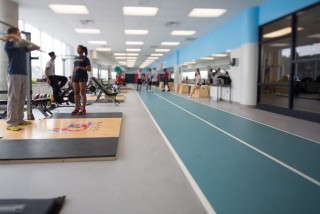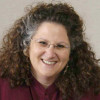Community Use of Schools

Publisher, Catapult Schools
Our schools are a public asset that some feel serve as a hub for the community. Currently, many schools are available for public use through permitting of spaces like the fields for local sports or classrooms for ESL classes. The Ministry of Education supports the Community Use of Schools (CUS) program as a means of enhancing school and public services and engaging the public at large. Catapult Schools reached out to Facilities and Trustee leadership for their perspective of the CUS program and some of Ontario’s top school architects reveal how planning and good design can support this ‘open door’ policy.

Explore Discussion
Provincial funding currently inadequate for keeping schools open to the public

Angelo Sangiorgio is the Associate Director, Planning and Facilities at Toronto Catholic District School Board.
I think the Community Use of Schools program is an important part of what we do in terms of outreach and making our schools accessible to the community at large. We receive about $1.4 million per year from the Education Ministry that we use to reduce the cost of accessing our facilities – but it doesn’t reduce completely the financial barriers for the use of space.
One of the biggest barriers is the cost to open the building. We have to have someone present to oversee the permit and that labour cost tends to be an obstacle. We design our new buildings and major additions and renovations in such a fashion that we have a wing of the building that becomes accessible to the community and is zoned to facilitate independent access. That makes it easier to supervise the permits so the caretaker can go about doing what they normally do in the afternoons and evenings without having to worry about people wandering through the building.
Another major issue is life cycle and maintenance costs. We have an active community use program at nearly 90% capacity. In the case of a smaller school with 300-400 small children, consider the impact of another 400 grown adults coming in a couple of times a week for an adult education or sports program. Everything from paper towels to the gym floor and door handles gets used up at a considerable faster rate. This has a significant impact on the estimated life cycle cost of the building due to wear and tear or damage. This means we have to consider the materials used. Funding from the Ministry is insufficient to cover the costs so we have to be clever when designing these spaces to make sure they are as long-lasting as possible, especially high traffic exterior areas like fields and playgrounds.
Sometimes it is the little inconveniences and disruptions that result from opening our doors that wears away our enthusiasm. For instance, many teachers prepare their classrooms in the spring for the new school year but return in the fall and things have been moved, changed or even missing as a result of permit group access. When there is the opportunity to address some of these issues in a new or renovated facility, we take it. It’s all in the planning!
Think in terms of life-cycle costing to improve community use schools

Paul Stevens is a Senior Principal at ZAS Architects and has directed many high-profile projects across Canada, Asia and the Middle East.
In Canada, our schools are some of the most highly utilized public assets in our communities and, wherever possible, we should promote school design that maximizes increased usage to support a broad range of users. We have an obligation, as designers and owners of these facilities, to consider community use as one of the major criteria for how we design school buildings. It shouldn’t just be given lip service with, say, a small door for the public off the gym. We should try to design to truly create community hubs and relieve some of the pressures on other facilities in the neighbourhood.
While community use of schools is of great benefit, it creates increased physical demands and wear and tear on our schools, which, over the years, causes them to look worn before their time. To successfully design schools explicitly for community use, they have to be more robust and with the ability to withstand the high usage they sometimes face.
To start, consider how schools are constructed in terms of their finishing materials. For example, a better quality material on the floor like ceramic tile, is going to wear much better than vinyl tile. In gymnasiums, quality equipment and materials that are more robust have a longer life cycle. While the temptation may be to use inexpensive materials to satisfy the budget, in the long term, it will cost Boards more in funds and inconvenience to repeatedly replace. There is also a more intangible impact, which is perceived student and staff value. Our children, staff and the community feel valued and do better when they see that they have a high quality school that has been designed to give them the best.
What it comes down to is trying to extend the life cycle of those community areas. It’s a question of prioritizing how costs are apportioned. Areas that are likely to get a far higher rate of utilization should be considered quite differently than lower usage areas. In any case, our schools have the facility infrastructure that many other community buildings don’t, and the importance of that needs to be supported, reinforced and encouraged.
Success hinges on redefining the school’s place in the community.

Shelley Laskin is the elected Trustee of Ward 11, at Toronto District School Board.
We think the Community Use of Schools program is important to the Toronto District School Board. However, we believe it should be expanded beyond its current scope, because it really only begins to reach those who we need to serve.
Expanding our definition of schools is what has to happen in order to use these building effectively and efficiently and serve the public. We have to shift people’s thinking away from the perception of schools as owned by exclusively by education. Rather we need to say, “these are key delivery sites for a multitude of services.” This has happened in other jurisdictions, so we don’t need to reinvent the wheel. There are many places in the world where they’ve begun to conceive of these spaces as public spaces, they just happen to be called schools.
The first step is for provincial governments, municipal governments and school boards to conceptualize these spaces as public spaces and create policy and funding agreements that state, “At the highest level, we commit to these public spaces being used differently and funded differently.” A local process would be developed that would require school boards and other public sector partners to think about space in a school in terms of the needs of the community – from an education perspective, from a health perspective, from a mental health perspective, from a public health perspective and any other public services that that community may need. When you allocate space based on that need and demographics of a particular community, you also use public space effectively and efficiently. But it would have to be supported by some really innovative thinking at the policy level provincially and municipally.
We are both glass-half-full kind of people. The more we elevate the discussion and take the glass-half-full perspective and talk about what’s possible from a policy and funding perspective, the better it is for those whom we serve. There are plenty of examples to demonstrate that we could move in this direction.
In collaboration with Cathy Dandy, former TDSB Trustee.
Understanding and measuring the costs improves the CUS program

David Fowler is the Manager of Facility Services at Limestone DSB and recent past Chair of the OMC committee of OASBO.
There is an overall expectation by the community that schools will be and should be available for public use. The Limestone District School Board (LDSB) recognizes that local groups and organizations have purposes and activities that are of social and educational value to communities in the district. It also recognizes that, in many communities, school buildings provide the only suitable meeting places for groups to pursue their activities. To effectively manage a program that benefits all, it is important to measure and understand the impact on our facilities. The current “pupil-place” funding model doesn’t address the additional and significant costs that can occur with community use.
Designing and managing schools for public use is a balance of what the community wants, what students need and what the board can afford to provide and maintain. It can be a challenge to address the functional requirements of public programming, and therefore, wear and tear on the physical space must also be factored in.
In 2009, Outreach Coordinators Charlyn Downie (LDSB) and Brandt Zatterberg (ALCDSB), developed the Cost Recovery Pricing Model. This tool uses cost accounting methodology and audited Board financial records to measure the cost of use per square foot per hour.
The safety and security of the school is also key. The entire building needs to be supervised and secure at all times, including after school hours, mainly by a caretaker but sometimes the principal or other staff. Having an effective school layout and good sight lines can facilitate efficient supervision of the school.
Everyone benefits when the community is welcomed. We want our schools to be open and welcoming, both practically and emotionally. Designing flexible spaces that can accommodate community partners is in our interest as, ultimately, these public groups are serving our children. When the school is designed to be open and active, with services that support our students, their families and society at large, we truly become the heart of the community.
In collaboration with Charlyn Downie, Outreach Coordinator, Limestone District School Board.
Opening school doors shows lifelong learning belongs in schools

Doug Snyder is the Founding Principal of Snyder Architects and has been engaged in the design and implementation of over 100 School Projects.
If the future of schools is to repurpose from places for teaching children, to places for life-long learning, the value of schools within the community will continue to grow.
A welcoming design supports engagement. Addressing the way students and the community access these community school buildings is key. Schools can have many entrances, and they often all look alike. With Community Use of Schools (CUS), it is important to make it obvious to everyone which doors are used for the school and which are for community use.
For example, we designed Jean Vanier Catholic High School in Milton, Ont., to have two community entrances that can function concurrently and independently; each with defined parking. The four gyms, surrounded by the upper level exercise gym and running track, can function independent of the rest of the school, with their own entrance and stair access to the mezzanine, landscaped forecourt and parking. This space is connected within the school to the central atrium, and has controlled and flexible access to the cafeteria and the hospitality program for events.
The principle school entrance also functions as a community entrance for adult learning & project space, community theatre, and larger, regional, sports events. Access from the atrium to the rest of the school can be controlled while allowing community members to enter the auditorium, art gallery, cafeteria and integrated tech shops as community project space which is open and easily supervised.
At St. Conrad CES, community access is centred around the Atrium, double gym & stage, with change rooms, a community meeting room, and the Custodial suite. There are two CUS entrances. Site design directs the community to these entrances, with ample views from the outside in, drawing visitors to the activity and people within. The Atrium is a central meeting and social space and an active place for parents and grandparents to meet at drop off/ pick up. These entrances and the Atrium are under the direct control and supervision of the Office during school hours, and supervised from the Custodial suite at all other times.
Imagine a school that welcomes in a community of all ages and purpose. Then students will know that learning only begins in school, and goes on for a lifetime. Learning is the new leisure.
Simcoe County faces space constraints, urban-rural challenges

John Dance is the Superintendent of Facility Services at Simcoe County District School Board.
We run the full gamut of community programs in our schools, from youth basketball and adult volleyball, to model car groups, Scouts, Cubs, Guides, continuing education classes and international language classes. It’s pretty wide ranging. The challenge is there’s never enough availability when everybody wants it.
We never have enough gym space in our locations that want gyms. For example, in Orillia we had three high schools but we closed one and we’re building a new one on that site, but that cost the community a full set of gyms during the rebuild. When you take a gymnasium out of use all of a sudden that creates an issue for community groups like a basketball groups or a volleyball groups.
But we’re also balancing urban and rural demands. The city of Barrie is 150,000 people and it’s got a large number of high schools and elementary schools of different makeups and designs and availability. The demand is always going to be high there, even with them having their own community centres with gyms and pools and arenas. But in a community like Elmvale our high school is the only high school in that community but residents might not think about using it: You may not have a critical mass for a group that will use it for men’s basketball every Friday night.
Where the populations are denser, you can never have enough community spaces. But in smaller areas, making community space available doesn’t necessarily mean it’s going to be filled. It’s not “build it and they will come.” It’s a longer-term process to make sure people know it’s available.
Getting everyone on board leads to effective shared spaces

Peter Hossack is Principal-In-Charge at Hossack & Associates Architects with 30 years of architectural experience focusing on Educational Facility projects.
The most interesting incorporation of the community use of schools that we’ve been involved with is the true shared use of a space that requires a design solution for multiple user groups. In these infrequent cases, the school board and ‘community user’ have to agree on a number of things: possible shared construction cost, shared operating and maintenance cost, life cycle costs, space designation, hours of use, separate access locations and even designating separate parking. These can be seen as challenges by Boards to the conventional operation and security of a school but, as architects acting as ‘problem solvers,’ we can guide the design team to identify issues and assist in providing solutions in the design process.
We recently had such a case when the Oakville Public Library requested a “neighbourhood library” to be incorporated into the library of a new elementary school. The design identified a solution acceptable to both parties. However, the extension of the design to perform for the whole community raised the interest of far more people in the remaining project phases and the community interest upon opening was very apparent.
When a school is identified by the community as available and useful for other public purposes it imbues additional value to the school facility. The group of users for a neighbourhood library encompasses a wide spectrum including school pupils, siblings, parents, seniors and others in the neighbourhood wanting to share a common community resource. When this happens, we think a higher sense of value and common ownership is instilled in the building, and the physical school building now functions with the added dimension of a facility that “belongs” to all of the local residents. This elevated value provides a stronger identity and appreciation that is greater than the sum of its parts.
As community resources continue to be under pressure for funding, the use of high quality, well-designed school facilities makes obvious economic sense in order to extend the use of schools to compatible community users. If addressed at the design stage, involving all parties, school design teams have the ability to both identify the questions that often inhibit relationships, and provide flexible, creative solutions for shared use.